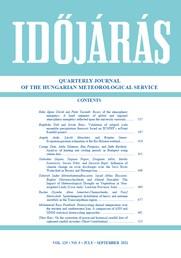Időjárás - Quarterly Journal of the Hungarian Meteorological Service (OMSZ)
Vol. 125, No. 3 * Pages 367–519 * July - September 2021
 |
|
 download [pdf: 3306 KB]
download [pdf: 3306 KB]
Basics of the atmospheric energetics: A brief summary of global and regional atmospheric energetics reflected upon the university curricula
Réka Ágnes Dávid and Péter Tasnádi
DOI:10.28974/idojaras.2021.3.1 (pp. 367–396)
Réka Ágnes Dávid and Péter Tasnádi
DOI:10.28974/idojaras.2021.3.1 (pp. 367–396)
Validation of subgrid scale ensemble precipitation forecasts based on the ECMWF’s ecPoint Rainfall project
Boglárka Tóth and István Ihász
DOI:10.28974/idojaras.2021.3.2 (pp. 397–418)
Boglárka Tóth and István Ihász
DOI:10.28974/idojaras.2021.3.2 (pp. 397–418)
Evapotranspiration estimation at the Kis-Balaton wetland
Angela Anda, László Menyhárt, and Brigitta Simon
DOI:10.28974/idojaras.2021.3.3 (pp. 419–430)
Angela Anda, László Menyhárt, and Brigitta Simon
DOI:10.28974/idojaras.2021.3.3 (pp. 419–430)
Analysis of heating and cooling periods in Budapest using station data
Csenge Dian, Attila Talamon, Rita Pongrácz, and Judit Bartholy
DOI:10.28974/idojaras.2021.3.4 (pp. 431–448)
Csenge Dian, Attila Talamon, Rita Pongrácz, and Judit Bartholy
DOI:10.28974/idojaras.2021.3.4 (pp. 431–448)
Influence of climate change on river discharges over the Sava River watershed in Bosnia and Herzegovina
Slobodan Gnjato, Tatjana Popov, Dragutin Adžić, Marko Ivanišević, Goran Trbić, and Davorin Bajić
DOI:10.28974/idojaras.2021.3.5 (pp. 449–462)
Slobodan Gnjato, Tatjana Popov, Dragutin Adžić, Marko Ivanišević, Goran Trbić, and Davorin Bajić
DOI:10.28974/idojaras.2021.3.5 (pp. 449–462)
Impact of meteorological drought on vegetation in non-irrigated lands
Tahereh Sadat Mirmohammadhosseini, Seyed Abbas Hosseini, Bagher Ghermezcheshmeh, and Ahmad Sharafati
DOI:10.28974/idojaras.2021.3.6 (pp. 463–476)
Tahereh Sadat Mirmohammadhosseini, Seyed Abbas Hosseini, Bagher Ghermezcheshmeh, and Ahmad Sharafati
DOI:10.28974/idojaras.2021.3.6 (pp. 463–476)
Spatiotemporal distribution of heavy and extreme snowfalls in the Transcarpathian region
Ruslan Ozymko, Alina Semerhei-Chumachenko, and Vasyl Manivchuk
DOI:10.28974/idojaras.2021.3.7 (pp. 477–490)
Ruslan Ozymko, Alina Semerhei-Chumachenko, and Vasyl Manivchuk
DOI:10.28974/idojaras.2021.3.7 (pp. 477–490)
Downscaling diurnal temperature over west and southwest Iran: A comparison of statistical downscaling approaches
Mohammad Reza Poodineh
DOI:10.28974/idojaras.2021.3.8 (pp. 491–511)
Mohammad Reza Poodineh
DOI:10.28974/idojaras.2021.3.8 (pp. 491–511)
On the correction of processed historical rainfall data of siphoned rainfall recorders (Short Contribution)
Tibor Rácz
DOI:10.28974/idojaras.2021.3.9 (pp. 513–519)
Tibor Rácz
DOI:10.28974/idojaras.2021.3.9 (pp. 513–519)
IDŐJÁRÁS - Quarterly Journal

Az IDŐJÁRÁS a HungaroMet Nonprofit Zrt. negyedévenként megjelenő angol nyelvű folyóirata
Megrendelhető a journal.idojaras@met.hu címen.
A szerzőknek szánt útmutató itt olvasható.
Megrendelhető a journal.idojaras@met.hu címen.
A szerzőknek szánt útmutató itt olvasható.









